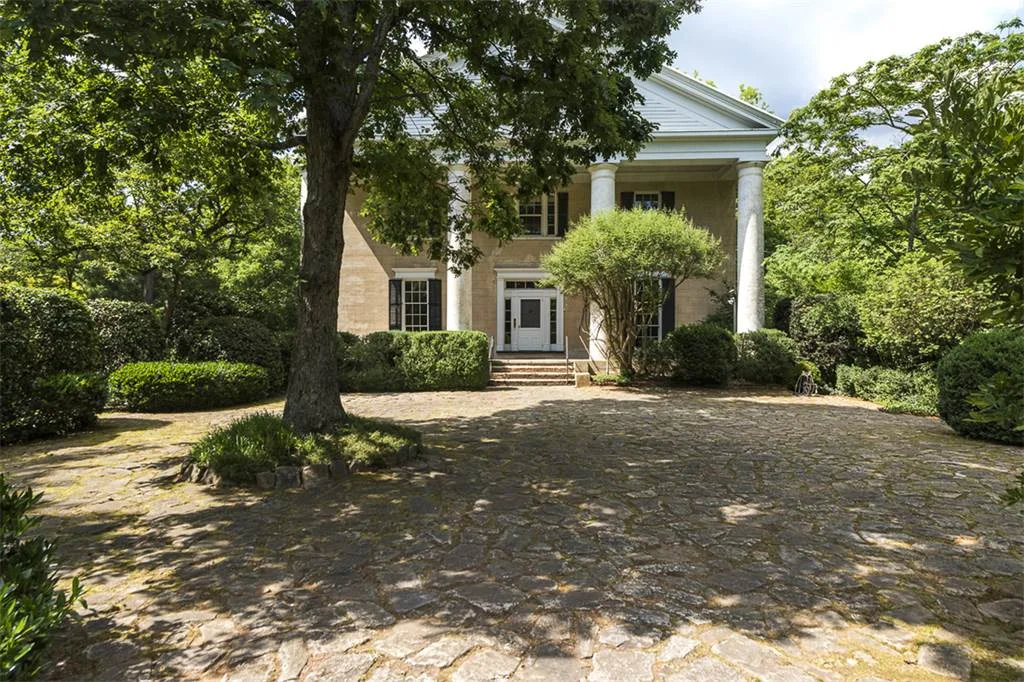History
THE HOUSE
Mimosa Hall was first built in 1841 for John Dunwody (1786-1858), a planter from coastal Georgia. A devastating chimney fire the same year caused the wooden walls to burn down. The house was rebuilt with brick walls and completed by 1846. Dunwody was a shareholder in the Roswell Manufacturing Company and a devoted member of the Roswell Presbyterian Church. John and his wife, Jane Bulloch, raised five sons and a daughter in the house. Their son Charles was the founder of Dunwoody, Georgia. When the Union army occupied Roswell in Summer 1864, Mimosa Hall was used as a hospital. The grounds were damaged, but the house remained intact.
By the late 1860s, the Dunwody children had all moved away, and in 1869, the house was purchased by General A.J. Hansell (1815-1888), the new manager of the Roswell Manufacturing Company. In addition to rebuilding the Roswell Mill after the Civil War, Hansell represented Roswell in the state legislature. He and his wife, Caroline Shepherd, had six children, all of whom were grown by the time the Hansells moved into Mimosa Hall. Mrs. Hansell is said to have given the house its name. After she died, her son, William, put the house and land up for auction.
The lucky bidder was Ada King (c.1856-1932), a recently widowed in-law of the King family that owned the Roswell Manufacturing Company. King had four sons and two daughters, both of whom were married in Mimosa Hall. King, an active member of the Daughters of the American Revolution, lived in the house from 1899 until 1918, when she sold it to Atlanta architect Neel Reid (1885-1926).
Reid, ambitious architect that he was, made his mark upon the house. He installed large grisaille panels in the central hallway, removed a partition wall to combine the two parlors on the ground floor, and designed furniture specifically for the house. After he died, his mother and sister continued to live in the house and operated a tea room there. They sold the house to cotton merchant Gus Tolson (1894-1972) in 1937.
Tolson was the president of the New York Cotton Exchange and he lived in New York City. He used Mimosa Hall as a summer house, although his mother, Jeanne, lived in the house year-round. Tolson, his wife, and his son, flew down from New York for occasional weekend visits. In 1947, Jeanne moved back to her native Louisiana and Gus sold the house to Atlanta lawyer Granger Hansell (1901-1968), great-grandson of General A. J. Hansell.
Granger Hansell and his wife, Sarah Belle Brodnax, were both deeply devoted to historic preservation. They hired an interior designer to furnish the house with period antiques that complemented the breezy, high-ceiling rooms. Sarah Belle was also a devoted community member; she was the first female bank director in Georgia and was also the president of the Atlanta Art Association.
The Hansells’ son, Ned, also a lawyer, moved into the house with his two daughters in 1968. This generation of Hansells devoted their energy to local charitable work. Ned was a chairman on the board of trustees for the YWCA and his wife, Sylvia, chartered the North Fulton Child Development Association Inc., in 1970. She helped raise $1 million to build a community center for local impoverished children.
Sally, the sixth generation of the Hansell family to reside in the house, inherited Mimosa Hall from her parents in 2012. She has been a passionate steward of history and has meticulously preserved both the house and gardens. In August 2017, she moved to the Hudson River Valley in New York and sold the house, as well as much of its historic furniture, to the City of Roswell.
THE GROUNDS
The Cherokee nation lived in the Roswell area until 1838. In May 1830, Georgia passed the Indian Removal Act which exchanged the Cherokee’s North Georgia land with a territory west of Mississippi. In 1831, surveyors began dividing North Georgia into lots which were awarded to prospective settlers via a land lottery. The Treaty of New Echota in 1836 ordered the Cherokee to leave the region within two years; in 1838, the government sent militia to forcefully remove 17, 000 Cherokee from the land.
Roswell and Barrington King, prospectors from coastal Georgia, purchased much of the land in what is now North Fulton County. They gave a ten-acre house lot to John Dunwody in 1838 as an incentive to build a house and settle in the new town of Roswell.
In addition to having Mimosa Hall built, John Dunwody had at least four slave quarters built on the property to house his approximately thirty slaves. He also had a carriage house on the property and a small garden in which his wife grew peaches and quince.
Although some of the growth on the property survived, much of the grounds was destroyed when the Union army camped there in 1864. In the 1870s, Caroline Hansell tried to restore the original Dunwody garden by planting lily of the valley and more mimosa trees.
Neel Reid had the greatest impact on the property, as he redesigned the grounds. He converted the area around the house into fifteen separate garden areas, one of which is believed to have been built on the original Dunwody garden. Reid designed a sunken garden, a reflecting pool with surrounding garden, a weeping tree garden, a rose garden, a cutting garden, and an allee. He also designed the stone courtyard in front of the house. Gus Tolson replaced the sunken garden with a swimming pool, but otherwise, the original garden rooms created by Reid still exist today.
Tolson and Granger Hansell both had ponies; likely Tolson is the one who installed a barn behind the house. The barn is said to have been a nineteenth-century grist mill. Behind the house is the original 1840s well.
FRIENDS OF MIMOSA HALL & GARDENS
While residents and visitors alike have always admired Mimosa Hall and its gardens, public interest in the property became especially keen in late 2016, when Sally Hansell listed the property for sale. As commercial developers began to set their sights on the gardens, concerned citizens, led by Michelle Slater and Gus Hadorn, rallied to encourage the City of Roswell to purchase and protect this beautiful historic property. Michelle, Gus and other concerned residents formed the Friends of Mimosa Hall & Gardens in Spring 2017 and elected a board of directors in August. The Friends group is working with the City of Roswell to plan the ongoing preservation of this cherished piece of Roswell’s history.
We are continuing to research the history of the Cherokee who lived in the area prior to and during the settling of Roswell as well as the contributions of the enslaved persons who lived at Mimosa Hall & Gardens. We hope to provide fuller information about the experiences of these and other underrepresented communities associated with the site in the near future.

